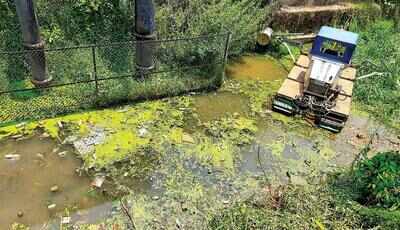Trending Topics
Picnickers, weekly market vendors dump plastic in Valvonti, choke river

The extent of pollution was on display as the WRD recently took up desiltation of the Valvonti
Keri: The Padoshe and the Sanquelim water treatment plants use raw water from River Valvonti to be treated and supplied for drinking purposes. But the river has been polluted due to open defecation and dumping of wet and dry waste. Adding to the problem are picnickers, who are found leaving behind large quantities of plastic which are now choking the river.
The extent of pollution was on display as the water resources department (WRD) recently took up desiltation of the Valvonti.
Sanquelim is known to experience flooding during the monsoon and the dumping of plastic and other wastes into the Valvonti is worsening flooding.
“We have started the work of desilting the nullah with the help of machines in Sanquelim market area and it will free the nullah from choking,” said WRD executive engineer K P Naik.
Though the Goa government has been among the first states in the country to discourage the use of single-use plastic by affecting environmental rules and regulations for the purpose, its indiscriminate use has continued. In Sanquelim town, Monday is the weekly market, at the end of which one can see huge quantities of plastic waste lying around or dumped in nullahs, posing a threat to the natural flow of the Maulangtad nullah, which eventually enters the Valvonti.
The Valvonti originates in the lush green forests of the Western Ghats of Karnataka in Chorla as the Haltara nullah. It is the water of this river which cascades as the Vazra-Sakhala waterfalls. The river enters Goa at Shiroli and joins the Kalti nullah at Ghoteli and eventually enters Sanquelim town as the Valvonti.
Wet and dry waste thrown into the river is affecting its water badly. The dumping of garbage by picnickers has often been brought to notice of the authorities by the local villagers. However, no concrete steps have been taken to curtail the indiscriminate dumping and this has badly affected the natural flow of the Valvonti.
The extent of pollution was on display as the water resources department (WRD) recently took up desiltation of the Valvonti.
Sanquelim is known to experience flooding during the monsoon and the dumping of plastic and other wastes into the Valvonti is worsening flooding.
“We have started the work of desilting the nullah with the help of machines in Sanquelim market area and it will free the nullah from choking,” said WRD executive engineer K P Naik.
Though the Goa government has been among the first states in the country to discourage the use of single-use plastic by affecting environmental rules and regulations for the purpose, its indiscriminate use has continued. In Sanquelim town, Monday is the weekly market, at the end of which one can see huge quantities of plastic waste lying around or dumped in nullahs, posing a threat to the natural flow of the Maulangtad nullah, which eventually enters the Valvonti.
The Valvonti originates in the lush green forests of the Western Ghats of Karnataka in Chorla as the Haltara nullah. It is the water of this river which cascades as the Vazra-Sakhala waterfalls. The river enters Goa at Shiroli and joins the Kalti nullah at Ghoteli and eventually enters Sanquelim town as the Valvonti.
Wet and dry waste thrown into the river is affecting its water badly. The dumping of garbage by picnickers has often been brought to notice of the authorities by the local villagers. However, no concrete steps have been taken to curtail the indiscriminate dumping and this has badly affected the natural flow of the Valvonti.
Start a Conversation
FOLLOW US ON SOCIAL MEDIA
FacebookTwitterInstagramKOO APPYOUTUBE







